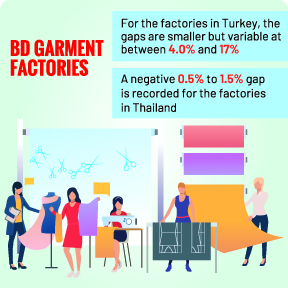
Gender pay gaps for base wage largest at 22pc-30pc
Monira Munni | Sunday, 24 March 2024
The garment factories in Bangladesh have the largest gender pay gaps between 22 per cent and 30 per cent for base wage, according to a latest study.
On the other hand, for the garment factories in Turkey, the gaps are smaller but variable, at between 4.0 per cent and 17 per cent while a negative 0.5 per cent to 1.5 per cent is recorded for the garment factories in Thailand.
The study 'Gender Pay Gaps in Global Supply Chains: Findings from Workplaces in Bangladesh, Colombia, Morocco, Thailand, and Turkey' by Anker Research Institute was published last month.
Primark, an Irish multinational fast fashion retailer and one of the big buyers of local RMG, funded for the studies in Turkey and Bangladesh.

Payroll data for around 15,000 workers from the five countries where wages for the entire workforce from production workers, cleaners, maintenance workers, and security guards to administrators, technicians, and managers irrespective of permanent, contract, seasonal and migrant workers were included in the analysis.
In Bangladesh and Thailand, the deviation from the national gender pay gap is between 10 per cent and 25 per cent for each workplace demonstrating the importance of measuring gender pay gaps at workplace level.
In the agri-food sector studies, the gender pay gap for base wages is largest for the fresh produce packhouse in Morocco, at 15 per cent, followed by 10 per cent for both banana farms in Colombia, and only 5.0 per cent for the fresh produce farm in Morocco, according to the report.
The gender pay gap is the ratio of average wage for women to average wage for men, expressed as a percentage difference.
A negative value means that average wages for women are higher than average wages for men. Base wage is the basic wage for standard working hours excluding overtime pay and cash allowances and bonuses.
The report found that in garment factories in Bangladesh and Thailand, women tend to work slightly more days per month than men but in Turkey and Colombia, men tend to work slightly more days per month than women.
These gender differences in days worked are sometimes counterbalanced by opposing differences in the amount of overtime worked - for example, in Bangladesh, men do more overtime hours than women each month, on average, in spite of working fewer days of the month.
The report found that the amount of overtime worked is associated with occupation more than gender.
The proportion of workers in the Bangladeshi garment industry who are women has decreased over the past decade due to an increase in the proportion of total production that is knitwear versus woven products.
Knitwear has a higher proportion of men than women because knitwear involves greater use of heavy machinery and this machinery is typically operated by men, it found.
There is considerable variation between countries in the average number of years of service, with workers in Turkey and Bangladesh generally having fewer years of service than workers in Thailand, Colombia, and Morocco.
Turnover rates are generally lower for women than for men in Turkey and Bangladesh though women and men leave for different reasons.
Men are more likely to leave for another job with higher pay, while women are more likely to leave for family reasons or social pressures, including leaving work after marriage or moving to where their husband works, or leaving to take care of children or elderly relatives.
In Bangladesh and Morocco, workers at the study workplaces are graded based on skill level, for both countries, women are more concentrated in lower skill grades than men.
"This is particularly problematic in Bangladesh, where most occupations have 'assistant' (grade 7), 'general' (grade 6), 'junior' (grade 5), and 'senior' (grade 4) skills levels.
In theory, workers should move up through grades 7 to 4 over time as they acquire more skills and experience," according to the report.
The findings indicate that women are not moving up through the grading system in the same way as men. This also limits women's access to supervisory positions. It found women frequently earn less than men doing the same type of work.
"This is usually because women do somewhat less skilled work than men in the same occupational group. For example, among sewing machine operators, men may operate a greater variety of sewing machines than women and therefore be paid more," it said.
For Bangladesh, it said men may be able to earn more than women doing the same work by negotiating a higher base wage or by switching factories for higher pay, especially when there are shortages of skilled labour.
In Bangladesh and Morocco, type of contract affects access to additional wage payments, and in Bangladesh, it also affects how workers are paid.
In Turkey and Bangladesh, some workers (especially men) said cutting and ironing are too physically demanding and involve too much risk for women, but other workers (especially women) disagreed and at several garment factories, there are at least some women doing these jobs which shows that women can do this work, according to the report.
It also said that in Bangladesh the need for accuracy to prevent fabric being wasted as a reason why women could not do cutting.
Women are excluded from occupations that involve night shifts (dyeing, knitting, printing, maintenance, security), partly because this requires the factories to take additional security measures but also because it is assumed that women or their families would not want women to work at night.
When asked, Bangladesh Garment Manufacturers and Exporters Association president Faruque Hassan said that they are working to reduce gender pay gaps gradually in the readymade garment sector.
munni_fe@yahoo.com